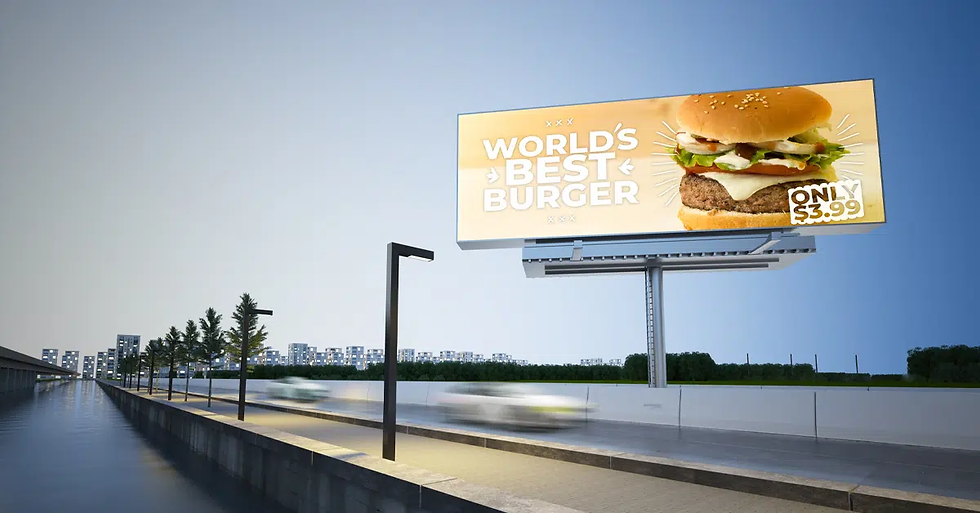What Is an LED Billboard Sign and How Does It Work?
- Cinstar LED

- 16 minutes ago
- 3 min read
In today’s fast-moving world, businesses are constantly looking for eye-catching ways to capture audience attention. Traditional print billboards are fading into the background, replaced by bright, dynamic, and high-resolution LED billboard signs. These advanced digital displays have completely transformed outdoor advertising, bringing motion, color, and interactivity to streets, highways, stadiums, and shopping centers. But what exactly is an LED billboard sign, and how does it work? Let’s dive in.

Understanding the LED Billboard Sign
An LED billboard sign is a large digital display that uses Light Emitting Diodes (LEDs) to create bright, vibrant visuals visible even in direct sunlight. Unlike static billboards that show a single printed advertisement, LED billboards are dynamic; they can display multiple ads, videos, and animations, all controlled digitally.
These digital marvels are widely used for LED billboard advertising, making it easier for brands to update campaigns instantly, target specific audiences, and run time-based promotions. From Times Square’s dazzling displays to digital highway boards across the United States, LED billboard signs have become the backbone of modern outdoor advertising.
How Does an LED Billboard Sign Work?
To understand how these digital displays function, let’s break down their main components and technology:
1. LED Modules
At the core of every LED advertising board are LED modules. Each module consists of hundreds or thousands of tiny LED bulbs arranged in a grid pattern. These diodes emit red, green, and blue (RGB) light, which combine to produce millions of colors.
The density of these LEDs determines the display’s resolution — the closer the pixels (measured as pixel pitch), the sharper the image. For example, a P6 LED display has a 6mm distance between pixels, while a P10 display has a 10mm distance.
2. Control System
An LED billboard’s control system acts like the brain of the display. It receives digital content (images, videos, animations) from a computer or cloud-based software and translates it into electrical signals. These signals control the brightness, color, and timing of each LED, bringing the visuals to life.
3. Power Supply
LED billboards use high-efficiency power supplies to ensure each diode gets the right amount of current. This is vital for maintaining brightness uniformity and color accuracy. Despite their brightness, LED billboard signs are remarkably energy-efficient compared to older lighting systems.

4. Cabinet Structure
Multiple LED modules are mounted onto steel or aluminum cabinets. These cabinets are weatherproof and designed to withstand heat, rain, and dust. They’re also modular, meaning technicians can easily replace or repair individual sections without dismantling the entire screen.
The Advantages of LED Billboard Advertising
The rise of LED billboard signs isn’t just about their visual appeal. They offer numerous advantages that traditional billboards simply can’t match.
1. Dynamic and Engaging Content
Instead of one static message, brands can display rotating visuals, video clips, and motion graphics. This helps capture attention more effectively and increases brand recall.
2. Cost-Efficient Over Time
While the initial cost of an LED advertising board may be higher than a traditional billboard, it eliminates printing and installation costs for each campaign. Advertisers can run new promotions at the click of a button, saving time and money in the long run.
3. High Visibility, Day or Night
LED billboards are incredibly bright, ensuring visibility in all lighting conditions. Automatic brightness sensors adjust the display for day or night, maintaining perfect readability without glare.
4. Environmentally Friendly
LED technology consumes less energy and doesn’t require paper or ink. The durability of LEDs also reduces waste, making digital billboards a greener advertising solution.

5. Remote Control and Flexibility
Advertisers can manage multiple billboards across different cities from a single computer. Want to update your promotion instantly? Just upload new creative content, no need for manual labor or printing delays.
Where Are LED Billboard Signs Used?
You’ve likely seen LED billboard advertising almost everywhere — but their applications are broader than most realize:
Highways and Roadsides: For brand promotions, public service messages, or real-time traffic updates.
Shopping Malls and Retail Stores: To attract foot traffic and display promotions.
Stadiums and Arenas: For live scoreboards, sponsorship ads, and fan engagement.
Airports and Train Stations: For informational displays and commercial advertising.
City Centers and Events: To create an immersive visual experience during concerts, festivals, or product launches.
The Future of LED Billboard Advertising
The future of LED billboard advertising is more interactive and data-driven. Integration with AI, motion sensors, and audience analytics allows real-time content personalization. For instance, ads can change based on weather, time, or nearby demographics, taking outdoor advertising to a whole new level.
As LED technology continues to evolve, expect higher resolutions, flexible screens, and energy-saving innovations that make billboards more sustainable and visually stunning.




Comments